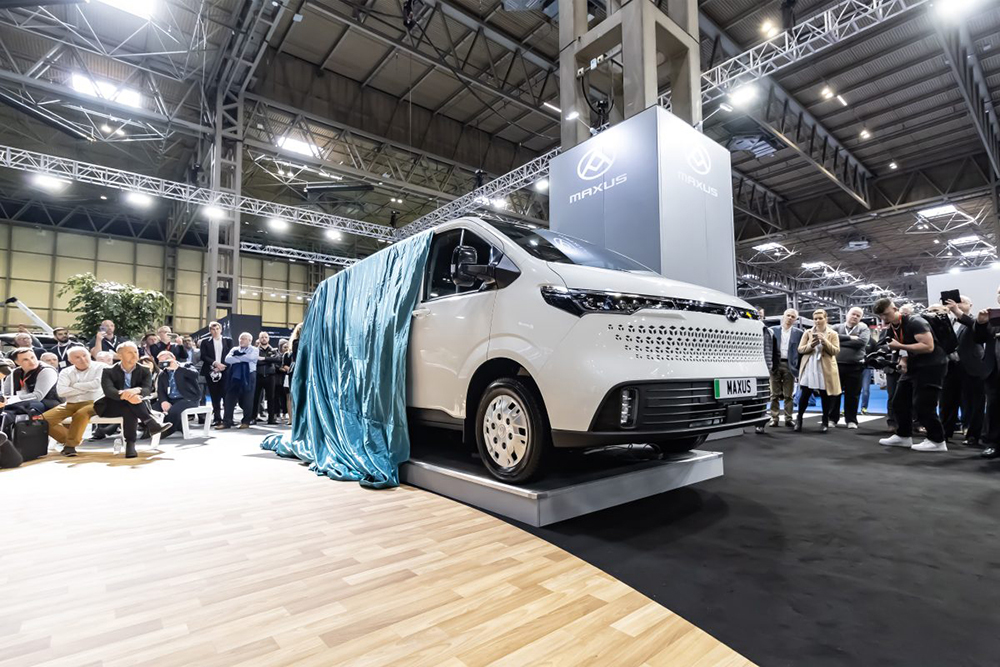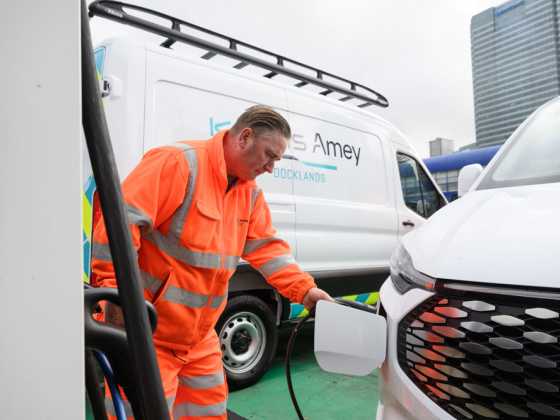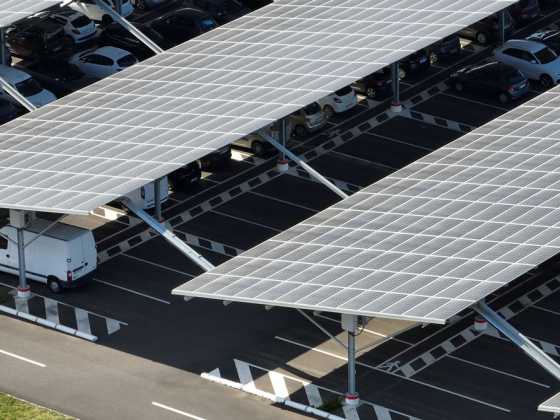Next generation trucks and vans showcased at the Commercial Vehicle Show

The 2023 Commercial Vehicle Show took place at the NEC in Birmingham from 18-20 April and demonstrated the innovation and industry investment going into the decarbonisation agenda
The Commercial Vehicle Show 2023 opened against a backdrop of urgent calls from the heavy goods vehicle sector for a government-led strategy to drive uptake of zero emission trucks to meet decarbonisation targets.
It follows new analysis from the Society of Motor Manufacturers and Traders (SMMT) which showed that Britain’s strategic road network has not a single HGV-dedicated electric charging or hydrogen filling point. This lack of infrastructure makes it impossible for the vast majority of operators to contemplate investments to decarbonise their fleets, putting critical CO2 emission savings of up to 21.1 million tonnes a year at risk.
From 2035, all new HGVs weighing under 26 tonnes sold in the UK must be zero emission – the same date as for the car and van sectors, despite the EV truck market being two decades behind that of passenger cars. The remaining heavier vehicles must be completely decarbonised five years later, but the initial deadline leaves many operators with just one full eight-year cycle of fleet renewal to make the transition. While investment announcements for public car charging infrastructure are gradually flowing through, there is no equivalent plan for HGV-dedicated infrastructure.
The latest electric and hydrogen-powered trucks were on show at the Commercial Vehicle Show, which shows a massive industry investment. But despite this, the SMMT research highlights there is still much more to do to give operators the confidence to invest.
Mike Hawes, chief executive of the SMMT said: “The question now is how we decarbonise a fleet that is still more than 99.4 per cent diesel powered, and on a broadly similar timeline to cars and vans, with an initial end of sale date looming in 2035. The CV Show provided the perfect platform for manufacturers and operators to discuss this mammoth challenge, and also for the launch of a range of new, cutting-edge electric and hydrogen models.”
Here’s a look at some of the latest innovation at the CV Show.
Greener trucks
The all-electric Nikola Tre BEV was seen for the first time in the UK on the IVECO stand at this year’s Commercial Vehicle Show.
The Nikola Tre BEV 4x2 has a 738kWh battery pack, consisting of nine modular 82kWh batteries, which powers its unique FPT Industrial e-Axle, producing 645 HP and 1,800Nm of instant torque.
The vehicle is capable of rapid charging at 350kW, achieving 10-90 per cent battery capacity in just 100 minutes, and a full charge gives this truck a range of up to 330 miles.
Hydrogen Vehicle Systems (HVS) used the Commercial Vehicle Show to lay out its plans to disrupt the haulage industry, showcasing its 40-tonne HGV technology demonstrator.
In addition to funding from the Advanced Propulsion Centre, Innovate UK, Scottish Enterprise and Energy Technology Partnership, HVS’ strategic investment partner is the service station and grocery corporation, EG Group, offering hydrogen refuelling infrastructure, fleet customer base and the potential for global scalability.
Jawad Khursheed, CEO of HVS said: “We are delighted to reveal our 40-tonne HGV at the Commercial Vehicle Show. This technology demonstrator showcases our ground-breaking hydrogen-electric commercial vehicle design and advanced powertrain technology. Our zero-emission trucks are a key part of decarbonising the logistics sector. Hydrogen is the perfect fuel for the haulage industry, offering long ranges and quick refuelling thanks to stations being easily integrated into existing key transport networks.”
HVS’ tractor units will be built on an all-new chassis, designed in-house around the hydrogen powertrain, which consists of pressurised hydrogen cylinders, fuel cells, an energy storage system and electrified rear axle.
HVS’ vehicle powertrain employs a fuel cell system and energy storage system to deploy electricity to an electric motor to transmit power to the wheels. It uses the KERS (Kinetic Energy Recovery System) to recapture energy under braking and while the truck is slowing down.
Typical refuelling time is comparable to diesel, around 20 minutes to replenish the high pressure hydrogen tanks.
Volta Trucks promoted its new 16-tonne all-electric Volta Zero vehicle at the Commercial Vehicle Show, which is designed for urban logistics and has an operating pure electric range of 95 to 125 miles. Thanks to the removal of the internal combustion engine, the operator of a Volta Zero sits in a central driving position, with a much lower seat height than a conventional truck.
Renault Trucks was present at the show with its battery electric 18T E-Tech D Wide rigid which is available through the Vertellus EV Discovery programme – a unique opportunity for fleets to test EV products in their operations for a fixed three-month period.
Mercedes-Benz Trucks showcased its battery electric Mercedes-Benz eActros LongHaul long-distance truck, which has a 600 kWh battery capacity and can cover around 310 miles on a single charge. Fuso’s Next Generation eCanter which is tailored to inner city distribution transport, was also on display.
Electric vans
Visitors to Nissan’s stand saw the new electric Townstar which has an electric powertrain that has been optimised with intelligent energy management and battery thermal cooling technology. This advanced system delivers a range of 183 miles WLTP Combined (or up to 269 miles on the City Cycle). The Townstar EV’s 45kWh battery offers both AC charging (11 kW or 22 kW) or DC CCS quick charging, the latter of which enables users to charge the battery from 15 per cent to 80 per cent in around 37 minutes.
IVECO made its UK debut of the eDaily at the 2023 Commercial Vehicle Show, which has a 248 miles range and allows for rapid charging of up to 80kW. The eDaily pioneers a modular battery concept, with customers able to specify their vehicle with one, two, or three 37kWh units. This allows operators to tailor their eDaily to its specific mission, balancing range with payload and journey patterns. Should the vehicle’s role change or subsequent owners need a different specification, IVECO dealers can add or remove batteries in as little as two hours.
Other benefits of the van include 3.5-tonne towing capacity, a truck-based chassis that carries 4.6-tonnes of payload and cargo volume of up to 19.6 cubic metres.
MAXUS unveiled its newest all-electric commercial offering – the eDELIVER 7, which bridges the gap between MAXUS’ current eLCV offerings of the smaller eDELIVER 3 and bigger eDELIVER 9.
The eDELIVER 7 has a range of 226 miles (WLTP combined) on a single charge (88kWh battery), and is available in three size configurations, with a payload of up to 1200kg. The eDELIVER 7 features a 150kW /330Nm high power, low energy motor with an acceleration time of 0-100km in 11 seconds.
Speaking at the launch of the eDELIVER 7, Mark Barrett, director of Harris MAXUS said: “The 2023 show marks our fourth vehicle launch at the NEC Birmingham, and our sixth EV vehicle launch in just seven years. In that time, we have positioned ourselves as a market leader when it comes to electric vehicles and the eDELIVER 7 builds on our EV range, securing our position in this regard.
“Our electric vans have proven popular with businesses in the delivery, pharma and grocery/retail sectors, as well as being the number one choice for many local councils that are looking to switch to electric. Our latest addition is pitched at those who need more payload capacity than the eDELIVER 3, but who may not need the full-size capabilities of our eDELIVER 9.”
MAXUS offered visitors a pure EV experience at the CV Show for the third consecutive year, with 12 zero emission vehicles on the stand. These included the eDELIVER 3 and eDELIVER 9 cabin van and chassis variants and an eDELIVER 9 minibus, MIFA 9 MPV and the T90EV on-road pickup truck.
Watt Electric Vehicle Company (WEVC) revealed its light electric van prototype at the show, codenamed WATT eCV1. It enables a wide range of electric commercial vehicle designs, facilitating mission-specific models which meet customers’ particular fleet requirements.
The first of multiple commercial vehicle offerings to come from WEVC, the eCV1 uses the company’s breakthrough, proprietary PACES architecture, a sophisticated yet cost-effective modular electric vehicle platform. Developed to support commercial vehicle manufacturers, specialist vehicle converters and fleet operators in the transition to an electric future, PACES complies with ISO regulations and exceeds stringent European Small Series Type Approval safety standards.
It’s ’cell-to-chassis’ system means batteries are integrated to the primary structure (rather than having a separate battery pack), optimising stiffness, minimising weight, and maximising payload. As a result, the clean sheet design means the eCV1 has none of the structural, weight and packaging compromises inherent in most electric LCV designs, many of which having been converted from ICE drivetrains and which are further constrained by traditional high volume manufacturing processes.
The WEVC eCV1 prototype has a kerbweight from just 1750kg, delivering class leading payload and range in the 3.5t and 4.25t segments.
Theatre programme
Complementing the vast range of vehicles, services and components on show was the live theatre programme, covering the future of the industry in the Road Ahead Theatre, and in-depth engineering expertise in the Workshop Theatre, in partnership with Commercial Vehicle Workshop.
Key speakers included Mike Hawes, SMMT’s chief executive, Rod McKenzie, RHA’s Executive director of communications, and Mike Cutts, director of Light Vehicle Business at Iveco, along with sessions covering van crime, driver safety and telematics. The Workshop Theatre featured a range of expert presentations, including battery technology, driver assistance systems and repair certification.






